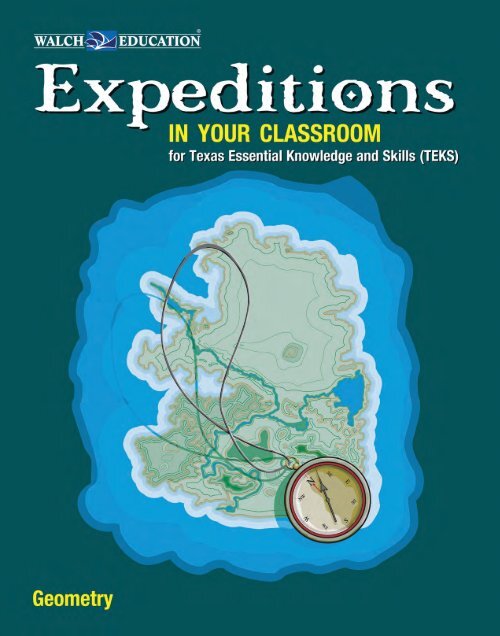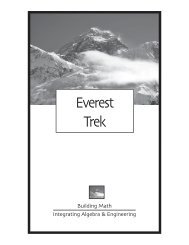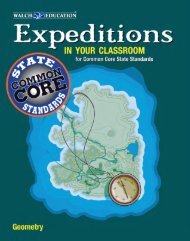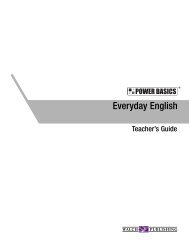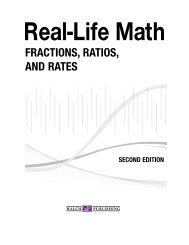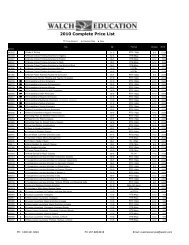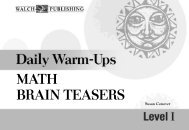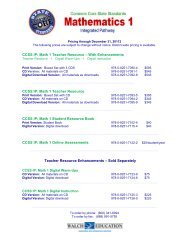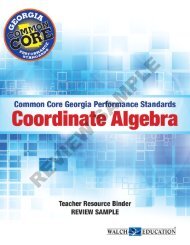Sample Pages - Walch Education
Sample Pages - Walch Education
Sample Pages - Walch Education
You also want an ePaper? Increase the reach of your titles
YUMPU automatically turns print PDFs into web optimized ePapers that Google loves.
Contents<br />
Introduction ..................................................................................... v<br />
Project Skills Chart ....................................................................... vii<br />
Geometry Project Assessment Rubric................................................. viii<br />
Project Putt-Putt................................................................................ 1<br />
Ripping Rooms................................................................................. 18<br />
Fashionistas....................................................................................... 40<br />
At the Scene of the Crime................................................................. 64<br />
Protectors of the Realm..................................................................... 95<br />
Superhero Challenge........................................................................ 113<br />
Thinking Outside the Box.............................................................. 130<br />
Director’s View............................................................................... 151<br />
This Is Air Traffic Control.............................................................. 168<br />
The Great Geometry Race............................................................... 195<br />
Expeditions in Your Classroom: Geometry © <strong>Walch</strong> <strong>Education</strong> i iii
Project Skills Chart<br />
Projects challenge students to flex more than one mental muscle at a time and integrate skills they<br />
often see dissected and covered in discrete math book chapters. Each project in this book has a<br />
core skill focus, but also gives students an opportunity to practice other skills. Use this chart as a<br />
reference to help you find the best project for your needs.<br />
C = Core skill<br />
X = Other skills covered (sometimes optional)<br />
Project<br />
Page<br />
Measurement<br />
Ratio and proportion<br />
Scale drawing<br />
Triangle and angle<br />
measurements<br />
Polygon<br />
Classifying polygons<br />
measurements<br />
Circle geometry<br />
Three-dimensional<br />
shapes and visualization<br />
Transformations<br />
Coordinate systems<br />
Calculating slope<br />
Geometric modeling<br />
Graph theory<br />
Basic trigonometry<br />
Project<br />
Putt-Putt<br />
1 X X C C X X X X<br />
Ripping<br />
Rooms<br />
18 X X C C X C X<br />
Fashionistas 40 X C X X C<br />
At the Scene<br />
of the Crime<br />
Protectors of<br />
the Realm<br />
Superhero<br />
Challenge<br />
Thinking<br />
Outside<br />
the Box<br />
Director’s<br />
View<br />
This Is Air<br />
Traffic Control<br />
The Great<br />
Geometry<br />
Race<br />
64 X X C C C<br />
95 X X X C C<br />
113 X X X X C C<br />
130 X X X X X C X<br />
151 X X X C C<br />
168 X X X X C C<br />
195 X X X X X X X X X X<br />
Expeditions in Your Classroom: Geometry © <strong>Walch</strong> <strong>Education</strong> vi vii
Geometry Project Assessment Rubric<br />
Percent of<br />
grade<br />
4 (Excellent) 3 (Good) 2 (Fair) 1 (Poor)<br />
Knowledge<br />
and skills<br />
specific to<br />
project<br />
Defines all key vocabulary, with<br />
examples. Recalls all formulas<br />
and methods correctly; can<br />
explain and apply to other<br />
problems. If required, work<br />
shows evidence of research<br />
on topic or theme.<br />
Defines majority of terms,<br />
with examples. Majority of<br />
formulas and methods<br />
applied correctly. Can<br />
apply to other problems<br />
with some incorrect<br />
answers. Shows evidence<br />
of research.<br />
Definitions and explanations<br />
are confusing or incorrect.<br />
Some formulas are used<br />
correctly. Shows little<br />
evidence of research.<br />
No knowledge evident.<br />
There are few correct<br />
methods and few correct<br />
answers. There is no<br />
evidence of research.<br />
Measurement/<br />
calculations<br />
Uses correct formulas. Includes<br />
all calculations and diagrams<br />
used for solution. Answers<br />
are correct.<br />
Majority of formulas are<br />
correct. Most work is<br />
shown. There are some<br />
incorrect answers.<br />
Some formulas are used<br />
correctly. Some work is shown.<br />
There are a number of<br />
incorrect answers.<br />
There are few correct<br />
formulas, little work shown,<br />
and a small number of<br />
correct answers.<br />
Drawing and<br />
modeling<br />
Final work meets criteria and<br />
exceeds expectations. All<br />
elements are included and<br />
correctly labeled. Work shows<br />
mastery of technique/technical<br />
skill. If required, scale and<br />
proportion are represented<br />
accurately.<br />
Final work meets criteria.<br />
Majority of elements are<br />
included and labeled. Work<br />
shows good command of<br />
technique/technical skill.<br />
If required, scale and<br />
proportion are represented<br />
accurately.<br />
Final work is missing important<br />
elements. Technique is weak.<br />
Scale and proportion are not<br />
represented accurately.<br />
Did not do work/contribute.<br />
Did not attempt to learn<br />
technique.<br />
Level of<br />
challenge<br />
Investigated difficult or<br />
complex situations.<br />
Investigated moderately<br />
difficult situations.<br />
Investigated straightforward<br />
situations.<br />
Investigated simplest<br />
or easiest situations.<br />
Final product Meets all criteria. Organization<br />
and information exceed<br />
expectations. Work reflects<br />
excellent understanding of<br />
project content.<br />
Meets all criteria.<br />
Organization and<br />
information are presented<br />
clearly. Work reflects good<br />
understanding of project<br />
content.<br />
Meets most criteria. Some<br />
elements or components<br />
are missing.<br />
Did not contribute. Did<br />
not submit or is missing<br />
major components.<br />
viii<br />
Expeditions in Your Classroom: Geometry<br />
© <strong>Walch</strong> <strong>Education</strong>
Geometry Project Assessment Rubric, continued<br />
Percent of<br />
grade<br />
4 (Excellent) 3 (Good) 2 (Fair) 1 (Poor)<br />
Presentation Completed within specific time.<br />
Evidence of preparation is<br />
obvious. Emphasized most<br />
important information. All team<br />
members were involved.<br />
Almost completed within<br />
time. Some preparation is<br />
evident. Covers majority of<br />
main points. Not all team<br />
members were involved.<br />
Almost completed within time.<br />
Little preparation is evident.<br />
Misses a number of important<br />
points. Not all team members<br />
were involved.<br />
Did not participate, did not<br />
prepare, was way under or<br />
over time, or information<br />
was confusing and<br />
disjointed.<br />
Teamwork Workload was divided and<br />
shared equally by all members.<br />
Most members, including<br />
student, contributed fair<br />
share.<br />
Workloads varied considerably.<br />
Student did not contribue fair<br />
share.<br />
Few members contributed.<br />
Student made little to no<br />
contribution.<br />
Class<br />
participation<br />
Contributed substantially. Contributed fair share. Contributed some. Contributed very little.<br />
Expeditions in Your Classroom: Geometry © <strong>Walch</strong> <strong>Education</strong> ix ix
Project Putt-Putt<br />
T eacher<br />
p<br />
age<br />
Overview<br />
Students design a miniature golf course. They create blueprints and a model for a new<br />
championship course.<br />
Time<br />
Total time: 6 to 8 hours<br />
• Before You Go—Reflection Inspection: 30 to 55 minutes<br />
• Before You Go—Uphill and Downhill: 15 minutes<br />
• Activity 1—Putt-Putt Blueprints: two to four 55-minute class periods<br />
• Concept sketch development: one to two 55-minute class periods<br />
• Scale drawings: one to two 55-minute class periods and one to two hours of homework<br />
• Activity 2—Mini Model: one to two 55-minute class periods and one to two hours<br />
of homework<br />
Skill Focus<br />
• angles and reflection<br />
• slope<br />
• two- and three-dimensional modeling<br />
Prior Knowledge<br />
• measurement<br />
• drawing to scale<br />
• basic understanding of angles and their properties<br />
Team Formation<br />
Students can work individually or in teams of two or three students.<br />
Lingo to Learn—Terms to Know<br />
• angle of incidence: the angle that a line makes with a line perpendicular to the<br />
surface at the point of incidence<br />
• angle of reflection: angle measurement between a reflected ray and a line<br />
perpendicular to the reflecting surface/line at the point of incidence<br />
• area: the number of square units needed to cover a surface<br />
• congruence: when figures or angles have the same size and shape<br />
• isometry: symmetry; a transformation that is a reflection or a composite of reflections<br />
(reflections, rotations, translations/slides, and glide reflections are isometries)<br />
Expeditions in Your Classroom: Geometry<br />
© <strong>Walch</strong> <strong>Education</strong><br />
1
Project Putt-Putt<br />
T eacher<br />
p<br />
age<br />
• line of reflection: a line used to create a reflection of a shape (reflecting line or mirror)<br />
• perimeter: the sum of the lengths of the sides of a polygon<br />
• ratio: a pair of numbers that compares different types of units<br />
• reflection: a transformation resulting from a flip<br />
• scale drawing: a drawing that is a reduction or an enlargement of the original<br />
• slope: the steepness of a line; the measure of change in a surface value over distance<br />
Suggested Steps<br />
Preparation<br />
• Review the list of materials and collect anything you will provide (a golf ball and<br />
marble for each team, art supplies, and so forth).<br />
• Review the Miniature Golf Course Hole Specifications in Activity 1. Adapt<br />
specifications to fit your skill focus. For example, you may wish to make sloped<br />
elements optional.<br />
Day 1<br />
1. Provide an overview of the project and review materials.<br />
2. Facilitate Before You Go: Reflection Inspection, which addresses angles of reflection.<br />
Let students practice and discuss observations. Show how to calculate angles of<br />
incidence and reflection using the tangent function.<br />
3. Introduce Before You Go: Uphill and Downhill, an activity on how to determine the<br />
slope and angle of slope of an incline.<br />
Homework<br />
If students have Internet access at home, have them use the Helpful Web Resources to learn<br />
about golf course design and look for examples of miniature golf courses. Encourage them to<br />
visit sites that highlight interesting or famous miniature golf courses.<br />
Day 2<br />
1. Explain Activity 1: Putt-Putt Blueprints.<br />
2. Review course holes and drawing specifications. Provide any specific criteria you have<br />
(for example, if you do not want students to include slope).<br />
3. If this is not an individual project, ask students to select a partner or assign groups.<br />
2<br />
Expeditions in Your Classroom: Geometry<br />
© <strong>Walch</strong> <strong>Education</strong>
Project Putt-Putt<br />
T eacher<br />
p<br />
age<br />
4. Provide due dates for assignments (freehand sketches, scale drawings) and/or specify<br />
whether class time will be used.<br />
5. Give students a refresher on ratio and scale if needed.<br />
6. Allow students to begin brainstorming and planning course hole ideas.<br />
Homework<br />
Have students continue to brainstorm ideas for their course holes and create a<br />
freehand sketch.<br />
Days 3 through 5<br />
1. Give students time to work on drawings. Alternatively, if done as homework, ask<br />
students to show signs of progress each day.<br />
2. Invite students to describe their ideas, show a first draft or revised sketch, and so forth.<br />
3. Check with students to make sure they are on target. Clarify any misconceptions.<br />
Design Due Date<br />
1. Have students hang design drawings around the classroom.<br />
2. Allow 5 to 10 minutes for viewing.<br />
3. Solicit observations and feedback. Discuss any design or construction challenges evident<br />
in drawings.<br />
4. Explain Activity 2: Mini Model. Review 3-D model criteria. Add other criteria<br />
appropriate to your situation and supplies.<br />
5. Assign a due date for models.<br />
Model Due Date<br />
1. Position course holes on desks around the classroom. Number each hole.<br />
2. Give students wooden craft sticks and marbles.<br />
3. Let students play a few rounds. You might also have them track scores on improvised<br />
score cards—notebook paper with three columns for hole number, hole par, and score.<br />
Expeditions in Your Classroom: Geometry © <strong>Walch</strong> <strong>Education</strong> 3 3
Project Putt-Putt<br />
T eacher<br />
p<br />
age<br />
4. Evaluate the course. Discussion questions might include:<br />
• Did anyone get a hole in one<br />
• Which course holes were most challenging and why Which course holes were<br />
least challenging<br />
• Does understanding reflection help your game<br />
Final Day<br />
1. Have students complete the Skill Check problems.<br />
2. Check and review answers.<br />
3. Have students complete the Self-Assessment and Reflection worksheet and<br />
submit it (optional).<br />
Project Management Tips and Notes<br />
• Review proposed designs. Student course holes tend to get complex! Some students<br />
may need redirection to simplify the design. Others may need a gentle reminder that<br />
the geometry of the course hole and how it plays are more important than appearance.<br />
• As written, the project specifies that course holes be as big as a student’s desk and no<br />
bigger than two or three desks. You may want to limit designs to one desktop. This<br />
is great for practical reasons (supplies, space); however, students may find the space<br />
tight for a course hole that should include two bounces and a slope. You can also give<br />
a range of dimensions (for instance, larger than 2 feet by 2 feet but smaller than 4 feet<br />
by 4 feet). The space doesn’t need to be square.<br />
Suggested Assessment<br />
Use the Geometry Project Assessment Rubric or the following point system:<br />
Team and class participation<br />
Two scaled hole drawings<br />
15 points<br />
40 points<br />
3-D course hole model 40 points<br />
Project self-assessment<br />
5 points<br />
4<br />
Expeditions in Your Classroom: Geometry<br />
© <strong>Walch</strong> <strong>Education</strong>
Project Putt-Putt<br />
T eacher<br />
p<br />
age<br />
Extension Activities<br />
• Technologically inclined students may use The Geometer’s Sketchpad<br />
(www.dynamicgeometry.com) or other tools to calculate and model angles before<br />
creating sketches.<br />
• Consider having students use a computer-aided design (CAD) program to draft a<br />
blueprint or three-dimensional model of their course hole.<br />
• Explore other angles involved in golf: a golf swing, golf clubs, the position of course<br />
holes in relation to one another, and so forth.<br />
• Ask students to identify and price the materials they need to build their course hole.<br />
• As a class, design and build a real miniature golf course. Hold a tournament involving<br />
local leaders. Use the event as a fund-raiser. (See Junkyard Golf & Potluck:<br />
http://junkyardsports.com/events/golfest.pdf)<br />
Texas Essential Knowledge and Skills Connection<br />
Geometry<br />
2. Geometric structure. The student analyzes geometric relationships in order to make<br />
and verify conjectures. The student is expected to:<br />
b. make conjectures about angles, lines, polygons, circles, and three-dimensional<br />
figures and determine the validity of the conjectures, choosing from a variety of<br />
approaches such as coordinate, transformational, or axiomatic.<br />
6. Dimensionality and the geometry of location. The student analyzes the relationship<br />
between three-dimensional geometric figures and related two-dimensional<br />
representations and uses these representations to solve problems. The student is<br />
expected to:<br />
a. describe and draw the intersection of a given plane with various three-dimensional<br />
geometric figures.<br />
c. use orthographic and isometric views of three-dimensional geometric figures to<br />
represent and construct three-dimensional geometric figures and solve problems.<br />
8. Congruence and the geometry of size. The student uses tools to determine<br />
measurements of geometric figures and extends measurement concepts to find<br />
perimeter, area, and volume in problem situations. The student is expected to:<br />
a. find areas of regular polygons, circles, and composite figures.<br />
Expeditions in Your Classroom: Geometry<br />
© <strong>Walch</strong> <strong>Education</strong><br />
5
Project Putt-Putt<br />
T eacher<br />
p<br />
age<br />
11. Similarity and the geometry of shape. The student applies the concepts of similarity to<br />
justify properties of figures and solve problems. The student is expected to:<br />
a. use and extend similarity properties and transformations to explore and justify<br />
conjectures about geometric figures.<br />
Answer Key<br />
Before You Go: Uphill and Downhill<br />
1. Slope<br />
m = ∆y/∆x<br />
m = 9/18<br />
m = 1/2 or 50%<br />
2. Slope<br />
m = ∆y/∆x<br />
m = 8/10<br />
m = 4/5 or 80%<br />
Check Yourself! Skill Check<br />
1. Answers will vary.<br />
2.<br />
40°<br />
A40°<br />
50°<br />
50°<br />
90°<br />
B40°<br />
40°<br />
C100°<br />
40°<br />
50°<br />
6<br />
Expeditions in Your Classroom: Geometry<br />
© <strong>Walch</strong> <strong>Education</strong>
Project Putt-Putt<br />
Expedition Overview<br />
Challenge<br />
The International Pro Miniature Golf Tour is coming to your area. You are a tour champion<br />
turned course designer and have been asked to construct a unique and challenging course for<br />
the championship event. Tour planners want to see blueprints and a model immediately!<br />
Objectives<br />
• To explore transformational geometry and learn how to calculate angles of reflection<br />
• To calculate slope and angle of slope<br />
• To use measurement and geometry skills to create accurate scale drawings<br />
Project Activities<br />
Before You Go<br />
• Reflection Inspection<br />
• Uphill and Downhill<br />
Off You Go<br />
• Activity 1: Putt-Putt Blueprints<br />
• Activity 2: Mini Model<br />
Other Materials Needed<br />
• golf balls<br />
• graph paper<br />
• paper<br />
• colored pencils or crayons<br />
• ruler<br />
• protractor<br />
• cardboard or poster board<br />
• other recyclable construction materials (for example, paper towel rolls, containers,<br />
box covers, paper cups)<br />
• other art supplies (for example, construction paper, felt, water-soluble paint, clay)<br />
• scissors<br />
• glue<br />
• masking tape<br />
• marbles<br />
• wooden craft sticks<br />
Expeditions in Your Classroom: Geometry © <strong>Walch</strong> <strong>Education</strong><br />
7
Project Putt-Putt<br />
Expedition Overview<br />
Lingo to Learn—Terms to Know<br />
• angle of incidence<br />
• angle of reflection<br />
• area<br />
• congruence<br />
• isometry<br />
• line of reflection<br />
• perimeter<br />
• ratio<br />
• reflection<br />
• scale drawing<br />
• slope<br />
Helpful Web Resources<br />
• History of Miniature Golf<br />
www.terrastories.com/bearings/miniature-golf<br />
• IgoUgo—A Field Guide to Mini-Golf<br />
www.igougo.com/story-s1214255-Myrtle_Beach-A_Field_Guide_to_Mini-Golf.html<br />
• Professional Miniature Golf Association—Mini Golf Madness on The Travel Channel<br />
www.thepmga.com/Players/News/Mini_Golf_Madness/mini_golf_madness.php<br />
• Professional Miniature Golf Association—Miniature Golf, Mathematically Speaking<br />
www.thepmga.com/Players/News/Geometry/geometry.php<br />
• RekenWeb Games—KidsKount<br />
www.fi.uu.nl/rekenweb/en/welcome.xml<br />
(Click on “Mini Golf” link.)<br />
• U.S. ProMiniGolf Association—U.S. Miniature Golf and Mini Golf Courses<br />
http://prominigolf.com/uscourses.html<br />
8<br />
Expeditions in Your Classroom: Geometry<br />
© <strong>Walch</strong> <strong>Education</strong>
Project Putt-Putt<br />
Before You Go<br />
Reflection Inspection<br />
Goal:<br />
Materials:<br />
To learn about reflection<br />
one golf ball per group, graph paper, masking tape, pencils<br />
Directions<br />
1. Form your group. Gather materials and put the golf ball aside.<br />
2. Using graph paper, draw a line 4 to 5 inches long that represents a wall of your<br />
classroom. Decide how far from the line (wall) you want to position your hole. Mark<br />
this point on the graph paper. Label your hole point H. At the bottom of your graph<br />
paper, choose a point that represents your golf ball. Make the distance between this<br />
point and the line different from that of point H and the line. Label your ball point B.<br />
3. Pause for group discussion. Make predictions about the path the ball will take for a<br />
hole in one. Take turns sharing how you would visualize the path and mentally gear up<br />
for the shot.<br />
4. Draw the path on the grid. Label it “Shot 1.”<br />
5. Next, move the hole to a new location. Draw a second path. Label it “Shot 2.”<br />
6. Test your predictions. Select a section of wall. Use small pieces of masking tape to<br />
mark the ball starting point and your “hole.”<br />
7. Experiment with more shots by changing positions of the ball and the hole. If you have<br />
access to a space with two walls or solid vertical surfaces, try a few double-bounce or<br />
even triple-bounce shots. Don’t forget to make predictions first.<br />
8. Check your reflection prediction skills one more time. Show the path for a one-bounce<br />
or two-bounce hole in one below.<br />
golf ball<br />
hole<br />
Expeditions in Your Classroom: Geometry © <strong>Walch</strong> <strong>Education</strong><br />
9
Project Putt-Putt<br />
Before You Go<br />
9. What other factors might affect the path of a golf ball on a miniature golf course<br />
Write your ideas below.<br />
_ ___________________________________________________________________<br />
_ ___________________________________________________________________<br />
_ ___________________________________________________________________<br />
_ ___________________________________________________________________<br />
_ ___________________________________________________________________<br />
_ ___________________________________________________________________<br />
_ ___________________________________________________________________<br />
_ ___________________________________________________________________<br />
_ ___________________________________________________________________<br />
10<br />
Expeditions in Your Classroom: Geometry<br />
© <strong>Walch</strong> <strong>Education</strong>
Project Putt-Putt<br />
Before You Go<br />
Uphill and Downhill<br />
Goal: To review how to determine the slope and angle of slope of<br />
an incline<br />
Miniature golf courses often include interesting topography, including sloped or graded<br />
surfaces such as ramps, steps, or embankments along the sides. How steep such an incline<br />
is can be described by calculating the slope.<br />
Slope: m =<br />
∆y<br />
∆x<br />
or “rise over run” given as a ratio or percentage<br />
Directions<br />
Determine the slope for each diagram below.<br />
1.<br />
9 m<br />
Slope: ______________<br />
18 m<br />
2.<br />
Slope: ______________<br />
8" 10" 32"<br />
40"<br />
Expeditions in Your Classroom: Geometry © <strong>Walch</strong> <strong>Education</strong><br />
11
Project Putt-Putt<br />
Before You Go<br />
Activity 1: Putt-Putt Blueprints<br />
Goal: <br />
Materials:<br />
To create a scale drawing for a miniature golf hole of your<br />
own design<br />
computer with Internet access, colored pencils or crayons,<br />
paper, graph paper, marbles<br />
Directions<br />
1. Use your Helpful Web Resources and the Internet to learn about miniature golf course<br />
design. Be sure to take a look at some of the world’s most interesting and more wellknown<br />
miniature golf courses.<br />
2. Review the specifications for your miniature golf hole and develop three different<br />
hole ideas. Be creative! For example, choose a theme, a unique location, or interesting<br />
topography for your course hole.<br />
Miniature Golf Course Hole Specifications<br />
q The “golf ball” will be a marble.<br />
q Players should not be able to sink a ball in one straight shot. Your goal is to<br />
provide a challenge!<br />
q The ball must bounce off course sides and/or obstacles at least twice for a<br />
hole in one.<br />
q The hole must include obstacles, twists, or turns.<br />
q The design should use at least three quadrants of graph paper.<br />
q Include at least one incline or decline. Vertical drops may also be included.<br />
q Challenge: There should be at least two unique shots a player could use to get<br />
a hole in one.<br />
3. For each of your three ideas, create one freehand aerial view sketch. Show what<br />
your course hole would look like. Label important elements of the course (tee, hole,<br />
obstacles). Add other fun details—the name of the hole, a snack bar, a clubhouse, and<br />
so forth.<br />
(continued )<br />
12<br />
Expeditions in Your Classroom: Geometry<br />
© <strong>Walch</strong> <strong>Education</strong>
Project Putt-Putt<br />
Off You Go<br />
4. Review your ideas. Get feedback. Test each concept! For example, use a small ball or<br />
marble and other temporary objects to test possible shots, angles, reflection, level of<br />
difficulty, and so forth.<br />
5. Choose one idea. Create two accurate scale drawings for this idea: an aerial view and a<br />
cross-sectional (side) view. Follow the Scale Drawing Criteria below.<br />
Miniature Golf Course Scale Drawing Criteria<br />
q Draw the sketch accurately to scale.<br />
q Provide a legend indicating scale.<br />
q Use lines exactly where the ball would travel. Tip: Make a photocopy of your<br />
aerial view drawing and use the photocopy as a draft until you are sure you<br />
have the paths.<br />
q Mark the points the ball must bounce off of for each hole in one.<br />
q Provide distance and angle measurements. Include the following<br />
measurements:<br />
q perimeter of the course<br />
q height of sides<br />
q length and width of the course or course sections<br />
q location of the tee, hole, and other obstacles relative to sides and other<br />
course elements<br />
q total surface area of the hole<br />
q obstacle dimensions (height, width, clearance, etc. as appropriate)<br />
q diameter, circumference, and length of any tunnels included<br />
q slope and angle measurements for course inclines<br />
q height of any vertical drops<br />
q Work is to be neat and colorful. Course elements should be well-labeled (tee,<br />
hole, obstacles).<br />
General rule: If an item on your course can be measured, provide a measurement. For<br />
example, if you include a dinosaur obstacle, provide the height, the width at the base, the<br />
distance between the dinosaur’s feet, and the clearance under the obstacle.<br />
Expeditions in Your Classroom: Geometry © <strong>Walch</strong> <strong>Education</strong><br />
13
Project Putt-Putt<br />
Off You Go<br />
Activity 2: Mini Model<br />
Goal:<br />
Materials:<br />
To create a three-dimensional model of your miniature golf<br />
hole design<br />
cardboard, poster board, other recyclable materials (paper<br />
towel rolls, containers, cardboard boxes, box tops),<br />
construction paper, clay, other art supplies<br />
Directions<br />
1. Create a three-dimensional model of your course hole. Be sure to follow any additional<br />
instructions provided by your teacher.<br />
Miniature Golf Course Hole Specifications<br />
q Your model should be as large as your classroom desktop and no larger than<br />
two or three desktops. Follow any specific size instructions provided by your<br />
teacher.<br />
q Your model must be constructed accurately to scale.<br />
q Include all important course elements: course sides, tee, hole, incline/decline,<br />
and obstacles. You can also add creative touches or decorations that fit your<br />
theme. Use recyclable or reusable materials. For example, use construction<br />
paper for grass. A paper towel roll or a toilet paper roll can be cut and rolled<br />
more tightly to create a horizontal tunnel or vertical drop.<br />
q Give your hole a name (for example, Dragon’s Lair or Shipwreck Island).<br />
q Mark points where the ball must bounce for a hole in one.<br />
q Mark “par” for your hole in a visible location.<br />
2. Bring your final model to class.<br />
3. Set up holes around the classroom and play a few rounds of miniature golf!<br />
14<br />
Expeditions in Your Classroom: Geometry<br />
© <strong>Walch</strong> <strong>Education</strong>
Project Putt-Putt<br />
Off You Go<br />
Skill Check<br />
1. You are in the final match of the National Pool Championship. Things haven’t been<br />
going your way, but it’s your turn now. You are solids. What is your shot strategy<br />
Assume that no other balls move during shots except the cue ball. Because of your<br />
talent, the cue ball follows your shot and stops in good position for the next shot.<br />
You hit each of your balls straight on (no fancy spins). Number and illustrate the<br />
paths for your final series of shots. Mark the cue ball location for each shot with an<br />
X (X1, X2, X3, etc.).<br />
cue ball<br />
eight ball<br />
your ball<br />
opponent’s ball<br />
2. What are the measures for angles A, B, and C in this highly skilled, three-bounce<br />
miniature golf shot<br />
40˚<br />
A<br />
C<br />
B<br />
Expeditions in Your Classroom: Geometry © <strong>Walch</strong> <strong>Education</strong><br />
15
Project Putt-Putt<br />
Check Yourself!<br />
Self-Assessment and Reflection<br />
Project Management<br />
Before You Go<br />
q I understand the concept of reflection. I know how to predict the angle a golf ball will<br />
reflect off a miniature golf course wall.<br />
q I know how to calculate slope.<br />
q I’m honestly not sure I understand the math involved and have asked my teacher for<br />
additional help.<br />
Off You Go<br />
q I reviewed our project challenge and project materials carefully.<br />
q I understood the requirements of products I created: three concept sketches, two scale<br />
drawings for my best idea, and a three-dimensional model of my course hole.<br />
q I carefully reviewed the Miniature Golf Course Hole Specifications before<br />
brainstorming ideas.<br />
q I completed concept sketches for three hole ideas. I tested my ideas and got feedback.<br />
q I completed two scale drawings for my course hole: an aerial view and a cross-sectional<br />
view. Both are drawn accurately to scale, include all required measurements, and are<br />
neat and well-labeled.<br />
Do You Know<br />
q I can define the Lingo to Learn vocabulary terms for this project and give an example<br />
of each.<br />
q I completed the Skill Check problems and carefully reviewed problems I answered<br />
incorrectly.<br />
16<br />
Expeditions in Your Classroom: Geometry<br />
© <strong>Walch</strong> <strong>Education</strong>
Project Putt-Putt<br />
Check Yourself!<br />
Reflection<br />
1. What were the most challenging aspects of this project for you and why<br />
_ ___________________________________________________________________<br />
_ ___________________________________________________________________<br />
_ ___________________________________________________________________<br />
_ ___________________________________________________________________<br />
2. What skills did this project help you develop<br />
_ ___________________________________________________________________<br />
_ ___________________________________________________________________<br />
_ ___________________________________________________________________<br />
_ ___________________________________________________________________<br />
3. If you did this project again, what might you do differently and why<br />
_ ___________________________________________________________________<br />
_ ___________________________________________________________________<br />
_ ___________________________________________________________________<br />
_ ___________________________________________________________________<br />
Expeditions in Your Classroom: Geometry © <strong>Walch</strong> <strong>Education</strong><br />
17


